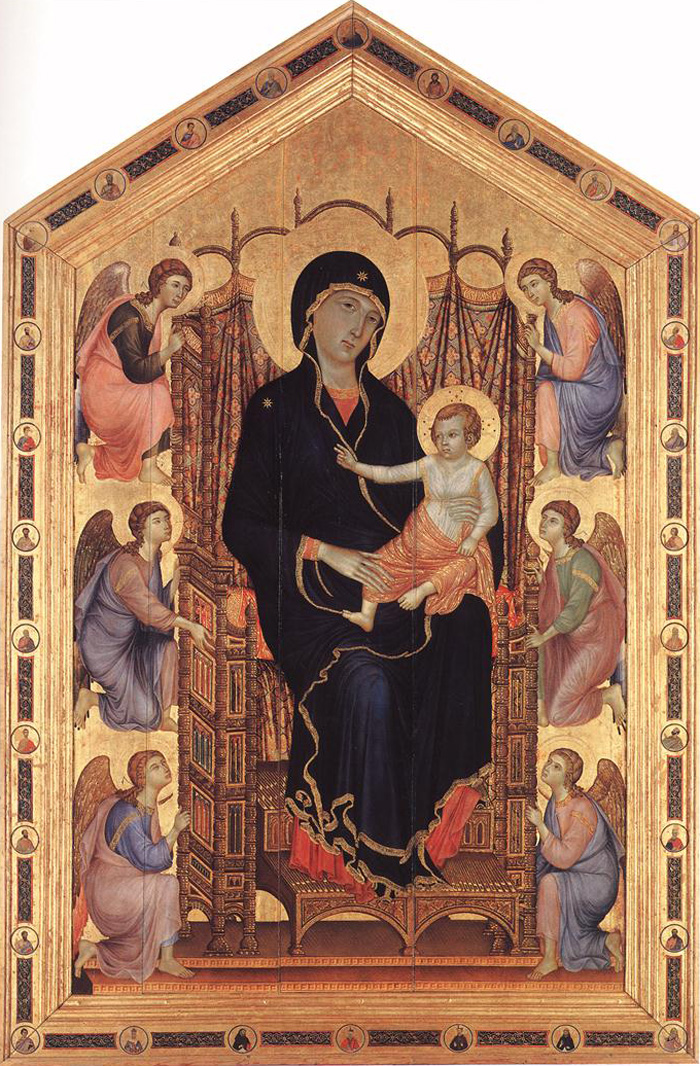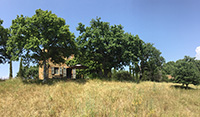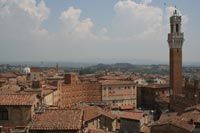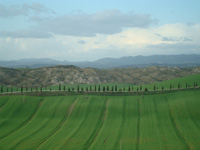| |
|
Considering the general scarcity of documents regarding the lives of Italian medieval painters, information concerning Duccio di Buoninsegna is unusually plentiful. This allows us not only to trace the more important stages of his artistic career but also reveals the restless temperament underlying the elegant dignity of his style.[1]
The understanding of Duccio's style depends on two documented works: the Madonna Enthroned, called the Rucellai Madonna, and the Maestà. Infusing new life into the stylized Byzantine tradition, Duccio initiated a style intrinsic to the development of the Sienese school — the expressive use of outline. The use of line varied from a vigorous quality in his rendering of narrative scenes to a lyrical and majestic tone in his portrayal of the Madonna and angels. In 1285 he was commissioned to paint a Madonna for Santa Maria Novella, Florence, today identified with the Rucellai Madonna (Uffizi).
|
 |
Duccio di Buoninsegna, Madonna Rucellai, (particolare Madonna), 1285 (commissione),
tempera e oro su tavola, 450×290 cm, Galleria degli Uffizi, Firenze [3]
|
The picture's name derives from the Rucellai Chapel of Santa Maria Novella where it remained, after being moved to several different places inside the church, from 1591 to 1937, the year of the Giotto exhibition. It was then transferred to the Uffizi. The panel was commissioned in 1285.
The painting has been the subject of much controversy among critics. In the fifteenth century it was thought to be the work of Cimabue, and this attribution, supported by Vasari, was accepted until the beginning of present century. The design of the frame decorated with roundels, the three pairs of angels flanking the throne and the sweeping gesture of the Child's blessing hand, show undeniable similarities to Cimabue's Maestà, now in the Louvre but at that time in the Church of San Francesco in Pisa. This may have been the inspiration of Duccio; Giorgio Vasari, in his Lives (not always completely reliable), documents a not improbable sojourn in Pisa.
The elements from Cimabue are enriched with delicate Gothic overtones, unknown at that time, but which were to become a permanent feature of Sienese art. The brilliance of colour, the curving outlines and the sinuous movement of the gilded edging of Mary's cloak are all new. The entire structure of the throne reflects the influence from beyond the Alps: the panels are slender mullioned windows, the foot-rest is supported by a light double arch, the back is crowned with delicate arching and little pinnacles.
The iconographical interpretation is also new in that the angels holding up the throne no longer form the crowning part of a solemn and magnificent background but are all looking towards the Virgin in attitudes of intense emotional participation.
|
 |
Brogi — Firenze. Chiesa di S. M. Novella. La testa della Vergine. (Part.re). Cimabue. — particolare Madonna,
[Duccio di Buoninsegna, Madonna con Bambino in trono e angeli (Madonna Rucellai), tavola, cm 450 × 290, Galleria degli Uffizi, Firenze] [8]
|
The connection with the 1285 contract is borne out by the painted frame that fulfils a specific iconographical purpose in accordance with the intentions of the Confraternity of the Laudesi. This was founded within the Dominican order, around 1244-45, with the object of fighting heresy by means of an intensive preaching programme. In the medallion placed at the top is the image of Christ. On his left are twelve figures, mostly prophets and patriarchs, among whom are: John the Baptist immediately next to the Redeemer, King David crowned and with the psalms, the young Daniel holding a roll. On the right of the Virgin, the Apostles, to whom the Child is turning to give his blessing, represent the New Testament. Peter and John the Evangelist are the first of the saints, many of whom are complete with books and scrolls that refer to the Gospel and in a more general sense underline the importance of preaching.
The roundels in the lower section, more easily visible to the faithful, contain images of the saints to whom the Laudesi and the Dominicans were particularly devoted. In the centre is St Augustine of Hippo, whose rule guided the Dominican friars. On the left are Catherine of Alexandria and Dominic. On the right is Zenobius, early medieval bishop and patron of the city, accompanied by Peter the Martyr, the then recently canonized founder of the Confraternity. The significance of the frame and the medallions is therefore not solely ornamental but conveys the commissioners' desire for self-proclamation: the Dominican brotherhood was to be visualized as a lay group championing the cult of the Virgin.
|
 |
Brogi — Firenze. Chiesa di S. M. Novella. Due Santi nella cornice del quadro di Cimabue. — particolare, sant'Agostino e santa Caterina d'Alessandria [Duccio di Buoninsegna, Madonna con Bambino in trono e angeli (Madonna Rucellai), tavola, cm 450 × 290, Galleria degli Uffizi, Firenze] [8]
|
| |
| |
|
|
|
| |
|

[1] Duccio di Buoninsegna (c. 1255-1260 – c. 1318-1319) was one of the most influential Italian artists of his time. Born in Siena, Tuscany, he worked mostly with pigment and egg tempera and like most of his contemporaries painted religious subjects. He influenced Simone Martini and the brothers Ambrogio and Pietro Lorenzetti, among others.
His works include the Rucellai Madonna (1285) for Santa Maria Novella (now in the Uffizi) and the fabled Maestà (1308–11), his masterpiece, for Siena's cathedral. The centre of the Maestà depicts the Virgin and Child enthroned and surrounded by angels and saints. He also painted a work known as the Stoclet Madonna, the name stemming from its previous ownership by Stoclet in his collection in Brussels. The Madonna, painted on a wooden panel around the year 1300, was purchased in November 2004 by the Metropolitan Museum of Art in New York City for an estimated sum of 45 million USD, the most expensive purchase ever by the museum. In 2006 James Beck, a scholar at Columbia University, stated that he believes the painting is a nineteenth century forgery; the Metropolitan Museum's curator of European Paintings has disputed Beck's assertion.
[2] Rucellai family | While prominent in communal government and wealthy as cloth manufacturers from the late 13th century, the Rucellai did not play a part of real importance in Florentine politics, preferring, especially in the 15th century, to devote increasing time to study and the cultivated pleasures of private life. Giovanni (1403-81) built the Rucellai Palace from 1446. This was from a design by Alberti, as was another of Giovanni's commissions, the marble façade of S. Maria Novella. He was also a more perceptive patron of artists than either Cosimo or Lorenzo de' Medici. His Zibaldone (commonplace book) gives valuable insight into the reading and manner of life of the lettered merchants of the Quattrocento.
His son Bernardo (1448-1514), a trusted supporter of Lorenzo the Magnificent, wrote a history of Charles VIII's invasion of 1494-95, De bello italico, which makes precocious use of the term 'balance of power', and his grandson Giovanni (1475-1525), who entered the Church, has some reputation as a literary pioneer. He wrote free imitations of classical poems in the vernacular and one of the earliest classicizing tragedies, Rosamunda. It was Bernardo who laid out the gardens off the Via della Scala which became known as the Orti Oricellari (Rucellai Gardens). After his death his grandson Cosimo acted as host to discussions held there on philosophical, literary and political topics. Machiavelli took part in these and his Discourses were dedicated to Cosimo and to another habitué of the Orti, Zanobi Buondelmonti. Machiavelli set his dialogues in 'The art of war' there, with Cosimo as one of the protagonists.
[3] Brogi — Firenze. Chiesa di S. M. Novella. La testa della Vergine. (Part.re). Cimabue. — particolare Madonna. © Copyright 2016 Fondazione Zeri, licenziato in base ai termini della licenza Creative Commons Attribution-Share Alike 4.0 International. Fonte: catalogo.fondazionezeri.unibo.it
|

National Gallery of Art, Washington, DC | Painting in Siena in the 14th and Early 15th Centuries
Siena, where most of the works on this tour were painted, is dominated even today by its cathedral, a dazzling facade of dark and light stone. In the fourteenth and fifteenth centuries, the centerpiece of its interior was a gold and brilliantly colored monumental altarpiece—Duccio's Maestà, some panels of which are in the Gallery's collection. Both the fame of the Maestà, which drew large numbers of pilgrims to Siena, and Duccio's influence as a teacher had a long-lived impact on the style of Sienese art. While painters in nearby Florence adopted rounder, more realistic forms, most Sienese artists in the early fourteenth century continued to prefer Duccio's linear and decorative style, which used gold and strong color to create pattern and rhythm.
Probably among Duccio's students was Simone Martini, whose reputation led him to work for the French king of Naples and for the pope, then living in Avignon. Through Simone the brilliant colors and rich patterns of Sienese art met the graceful and lyrical figures of French manuscript painting, evolving to form the International Style. Its refined and courtly manner dominated the arts across Europe at the end of the Middle Ages. Simone's chief competitors in Siena were the brothers Ambrogio and Pietro Lorenzetti, whose influence can also be seen on this tour. Like Simone they were probably assistants in Duccio's workshop, but while Simone painted with refined elegance, the Lorenzetti were concerned with the definition of three-dimensional space, narrative detail, and the depiction of everyday life.
In the thirteenth and early fourteenth centuries, a greater emphasis on human experience and perceptions prompted artists of many kinds to begin "speaking in the vernacular." Poets in Sicily invented and perfected the sonnet, and Dante wrote the Divine Comedy—not in Latin but Italian. Also for the first time, sermons were given in native Italian dialects by members of influential new religious orders, particularly the Franciscans and Dominicans, who left the shelter of monasteries to preach in cities and towns. Religion focused increasingly on human and humane concerns. The simple virtues of the early Franciscans—who renounced worldly possessions and identified strongly with Christ and his suffering—helped to shift emphasis onto Christ's human nature and to demand of religious art a new and closer identification with people's experience. Artists responded by enhancing the sense of particular time and place with detailed settings familiar to their viewers, by expanding the range of gesture and emotion, and by embroidering their narratives with anecdotal details.
|

Holiday accomodation in Tuscany | Podere Santa Pia | Artist and writer's residency
|
| |
|
|
|
|

. |
|
|
Podere Santa Pia |
|
Podere Santa Pia, garden view, December |
|
View from terrace with a stunning view over the Maremma and Montecristo
|
| |
|
|
|
|
|
|
|
|
|
Podere Santa Pia |
|
|
|
|
|
|
|
|
|
Siena, Palazzo Publico
|
|
Siena, Duomo |
|
Val d'Orcia |
| |
|
|
|
|
Siena
Siena is universally known for its artistic patrimony and for the substantial stylistic unity of its medieval urban architecture. It has been declared a UNESCO World Heritage site.
The Sienese territory is magnificent in every season. The past and the present, living nature, springs of beauty and health, traditions ... a land between art and nature! A land where history mixed with legend. The cities and villages bordering on the surrounding hills emerge intact from the long ago Medieval Age. The art in the cathedrals, in the churches, and in the mansions, the magic harmony in the little side-streets of the city and the vibrations of antique melodies in the country lanes, between fertile fields rich with olive groves and vineyards. The cypress keeps vigil on the hills, the last defender of the unpretentious Sienese landscape. The Sienese territory is rich with natural, incontaminated panoramas, perfectly preserved medieval villages, archaeological sites, cities of art like Siena, San Gimignano, Montalcino, Pienza, Montepulciano, etc.
Val d'Orcia
The Val d’Orcia is in the Province of Siena and enjoys splendid panoramic pastoral landscapes and various historic town centers that date back to the Medieval period.
An additional merit is that in 2004 it was recognized as a World Heritage Site by UNESCO. This area is characterized by its numerous cypress trees and by its vineyards which produce the renowned wine, Brunello di Montalcino, the “Orcia” DOCG.
Montalcino
Montalcino is a municipality in the province of Siena that has the good fortune of being situated in one of the most important areas dedicated to the cultivation of grapes for high quality wine.
In fact, the city is renowned worldwide for producing two DOC wines, Rosso di Montalcino and S. Antimo- and above all for its world renowned "Brunello", synonymous with the quality and history of Italian wine, known worldwide the prince of Tuscan and Italian wines. Montalcino's historic treasures like the medieval fortress, the cathedral, and numerous churches, make it a preferred destination for tourists visiting Tuscany.
Montepulciano
Montepulciano is a medieval town in the province of Siena. Of Etruscan origin, it was founded around the Fourth Century B.C. It is nestled above a very specialized agricultural landscape, where hills are mostly covered with vineyards and olive groves.
These very fine vineyards enhance the fame and notoriety of the town by producing the famous "Nobile di Montepulciano", a DOCG wine.
|
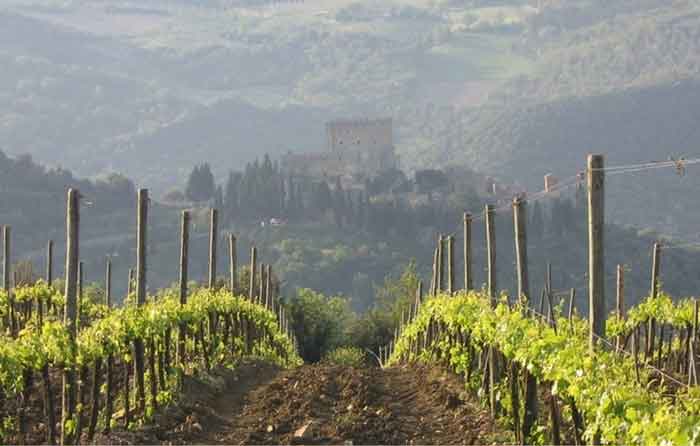 |
| |
|
|
